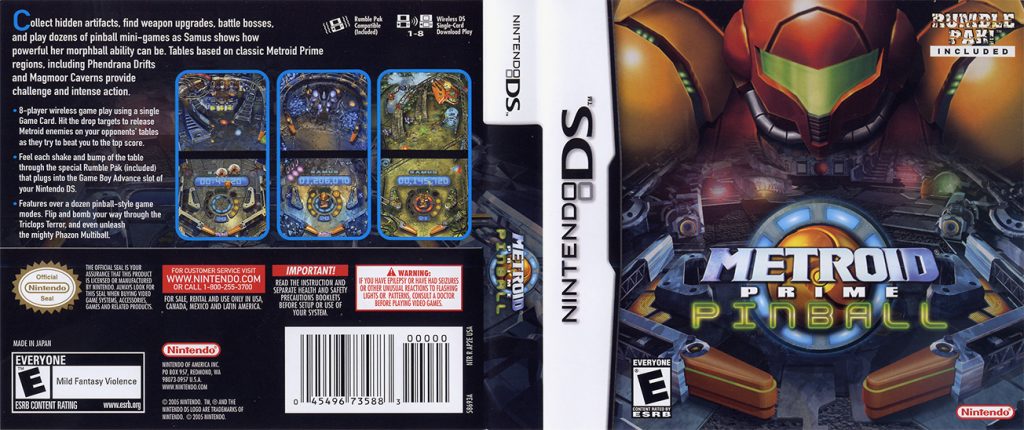Often considered the third series in Nintendo’s holy trinity, Metroid has been around for just as long as Mario’s been crashing the wrong castle in search of distressed damsels or Link’s refusal to go it alone. Yet despite this legendary designation, the galactic adventures of bounty hunter Samus Aran rarely get quite as much love and attention from the big N as they deserve. So strap on your Plasma Beams and power up those Varia Suits because all this week, we here at Nintendo Wire are going on a trip down memory lane through Metroid’s extensive 30-year history to explore what makes the series such an influential legend in the gaming industry — not to mention one of my favorite gaming franchises of all time.
Metroid: Zero Mission (Game Boy Advance)
Download on [Wii U]
Realizing that Metroid Fusion’s mechanics drastically differed from previous entries in the series, Yoshio Sakamoto — director of Zero Mission and co-creator of the Metroid series — wanted to return to the series’s gameplay roots by creating a game based on the original. Armed with this intent, the criminally overlooked and underplayed Metroid: Zero Mission was born: an enhanced remake of the original Metroid on NES, retelling the story of Samus’s first encounter with the Metroids and her initial battles with the nefarious Space Pirates on planet Zebes. Featuring a rebuilt version of the game engine used for Metroid Fusion, it marked the first time two installments in the Metroid series had been released on the same console.
To consider this classic gem anything more than your average remaster would be a grave mistake, as is quickly made clear to anyone who’s ever played it. Rather than produce a screen-for-screen remake of the 8-bit original, the development team was careful to take inspiration from various situations, locations, boss battles and enemies in an effort to reformulate an entirely new game design around them. In this way, Zero Mission adds just enough new elements to make it feel fresh and exciting while still managing to keep the lifeblood of the original intact. Most notably, the story arc is completely rewritten and much more structured than its NES counterpart thanks to some well-drawn comic book-style cutscenes that help explain some of the finer points of the narrative. There’s even an extended ending sequence once Mother Brain is defeated that pits the players as Zero Suit Samus featuring gameplay somewhat reminiscent of the SNES classic Flashback, which better fills in the chronological gaps between Metroid and Metroid Prime.
Bottom line, Zero Mission is one of the most ambitious and comprehensive remakes ever to grace the medium, and is often considered one of the best video games available on the Game Boy Advance. It deserves tremendous appreciation for successfully expanding on the series’s source material while retaining the best elements of what makes Metroid gameplay so addictive and appealing. The cherry on top? Players can unlock the original NES Metroid game in its entirety as a bonus for finishing the main adventure — no Game Link Cable required! Every Metroid fan owes it to themselves to play through this masterful recreation at least once in their lives.
Fun fact: Samus’s iconic Morph Ball was initially decided upon due to programmers having a hard time animating a crawling animation. Zero Mission features Samus’s crawling animation as a callback to the programmers’ original intent.
Metroid Prime Pinball (Nintendo DS)
Purchase on [Amazon]
The first and only spinoff title in the series (for now), 2005’s Metroid Prime Pinball is a re-imagining of the first Metroid Prime using — you guessed it — pinball machines. Borrowing a similar graphical style and storyline from the titular series, it proved a surprisingly addictive distraction during the wait for Samus’s next traditional adventure that plays relatively well thanks to engaging table layouts and realistic physics programming.
As you’d expect, the ball is (fittingly) Samus Aran in Morph Ball form as she’s flung frantically across both Nintendo DS screens in an attempt to acquire twelve Artifacts over six tables. In addition to the single player campaign, the game featured a multiplayer mode where up to eight players could compete in a race to reach a target score using a single cartridge. The game also came bundled with a Rumble Pak, marking the first time the accessory was made available for purchase on Nintendo DS systems. Despite the device’s harsh criticism and limited support in other games, I found it did help make the pinball experience feel slightly more authentic and enjoyable.
Overall, the unique blending of classic pinball gameplay with the Metroid universe was quite impressive and was generally well received by critics. Personally, I found the clever implementation of various staple gameplay elements commonly associated with the series endearing, with Samus’s wall climbing and shooting abilities deserving particular mentions. In this way, Metroid Prime Pinball manages to remain faithful to the main series while providing an entirely new twist on the pinball genre that fans won’t want to miss.
Fun fact: the idea to make a pinball game based on the Metroid series was largely inspired by Mario Pinball Land. More specifically, Nintendo producer Kensuke Tanabe felt Samus’s ability to morph into a ball could easily be adapted to a pinball setting, and thus approached Fuse Games to develop the game.
Stay tuned
That’s all for today, but come back tomorrow for the thrilling conclusion of our Metroid Memories series as we take a refreshingly honest look at the two black sheeps of the Metroidverse: Metroid Prime Hunters and Metroid: Other M.
Nintendo Wire is honoring Metroid’s 30th anniversary by hosting a series of celebratory articles commemorating the franchise’s rich history and influential impact on the action-adventure genre. Make the Galactic Federation proud and be sure to check out our previous entries to gain a better understanding of what makes Samus and her bounty hunting adventures such memorable masterpieces:
Metroid Memories, Part I — Metroid & Metroid II: Return of Samus
Metroid Memories, Part II — Super Metroid & Metroid Fusion
Metroid Memories, Part III — Metroid Prime trilogy
Metroid Memories, Part V — Metroid Prime Hunters and Metroid: Other M





